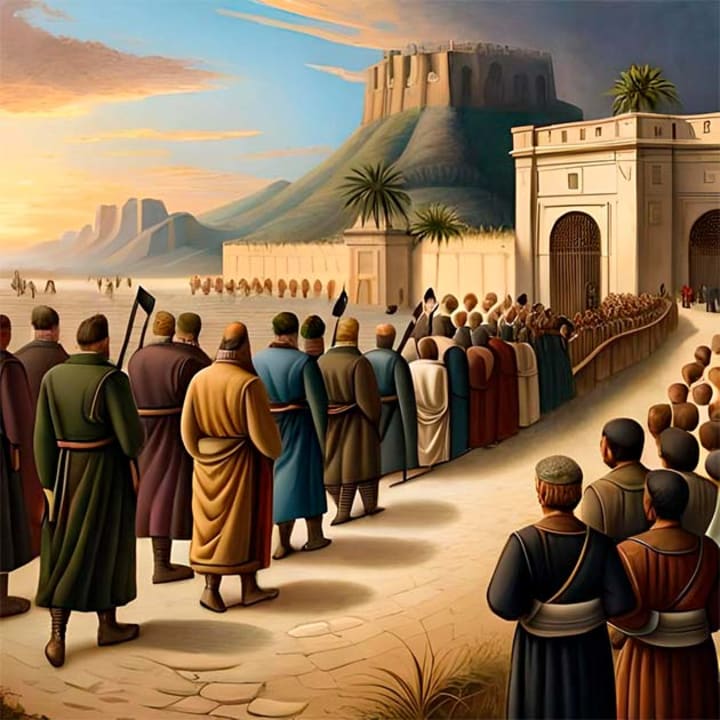The Legend of and the Ten Lost Tribes of Israel
Ancient History
Within the depths of ancient Jewish folklore resides a narrative imbued with intrigue and enigma, pertaining to the Ten Lost Tribes of Israel and their elusive boundary, the Sambation River. This legendary waterway has engrossed minds for countless generations, evoking inquiries regarding its actuality and the destiny of the tribes it purportedly safeguarded. In this investigation, we embark upon an exploration of the enigmatic essence of the Sambation River and the enduring enigma surrounding the Ten Lost Tribes.
The legend of the Sambation River is believed to have originated over 2,000 years ago, or possibly even earlier, and it has undergone numerous revisions since its initial description in the first century AD. This mythical river is mentioned in various cultures and Jewish writings, and it is a combination of different stories that developed independently.
According to ancient Jewish texts, the Sambation River was no ordinary waterway. It was described as a river that roared with immense force, making it seemingly impossible to cross. Legends spoke of the deafening noise caused by the river's violent currents, which carried heavy stones that obstructed any attempt to traverse its mighty waters.
The river's name, Sambation, derived from the Hebrew word Shabbat (Sabbath), alluded to a peculiar phenomenon—the river's stillness and cessation of its raging torrent on the Sabbath day, the single day that Jews are unable to pass it.
Inquiry into the Location of the Ten Lost Tribes of Israel
The Ten Lost Tribes of Israel, who were exiled by the Assyrians in the eighth century BC, have been the subject of numerous speculations and quests to determine their whereabouts. Ancient accounts place these tribes near the Sambation River, isolated from the rest of the world. However, which tribes were these? Did they truly disappear? Were they annihilated or assimilated? Or do their descendants still exist, concealed from modern view?
According to one narrative, the Levites or Sons of Moses are the ones obstructed by the river, while Judah and Benjamin were dispersed among the nations. In this version of events, God guided the Levites to the river for their protection and sealed the path behind them so that no one could locate them. Meanwhile, a blazing fire shielded the Levites from outsiders when the river was calm.
The account given by Eldad Hadeni differs slightly; there, a mystical cloud conceals the Levites on Saturday. A comparable story exists in Islamic sources, which may parallel Jewish sources that did not survive. The difficulty with these stories is that it is challenging to accept that the Levites were separated from the Israelites and the Judaeans.
The Bible states that the Levites intermingled with the Judaeans and shared their exile to Babylon; they may not have been exiled with the Ten Israelite Tribes. Although the Levites resided in all the major cities in the Israelite territories, King Jeroboam appointed priests who were not Levites. Consequently, the Levites joined the Judaeans.

By the 6th century AD, it was unanimously acknowledged among Jewish sources that the Ten Lost Tribes were the ones obstructed by the Samation River. Concurrently, Islamic sources from that era consistently portrayed a substantial community descended from Moses, who abstained from the transgression of worshipping a false deity or idol, commonly known as the Sin of the Golden Calf. This virtuous conduct bestowed upon them divine safeguarding. Alternative accounts, while not emphasizing this specific transgression, depicted the group as morally upright, thereby facilitating the incorporation of the Lost Ten Tribes within this community in subsequent sources.
The search for the true location of the Sambation River remains a topic of great intrigue and speculation. Scholars and explorers alike have dedicated their efforts to unraveling the mystery surrounding its precise whereabouts. Proposed sites have spanned a wide range, from the commonly suggested Mesopotamia to even as far as China.
Other endeavors have placed the Sambation River in Armenia, a region known for its ancient kingdom situated in the eastern part of Anatolia and the southern Caucasus region. Additionally, Central Asia, specifically Kazakhstan or Turkmenistan, and Transoxiana, a historical region encompassing parts of modern-day Uzbekistan, Tajikistan, and Turkmenistan, have also been considered as potential locations for the elusive river.
An equally intriguing question arises as to how the river disappeared from the geographical records. However, thus far, no tangible evidence has been discovered. The absence of concrete geographical markers has allowed the legend to persist, and the phenomenon of a river that only flows on the Sabbath continues to be recounted.
In the pursuit of locating the Ten Lost Tribes of Israel, the focus has shifted towards DNA analysis. Additionally, attention has been given to the Levites and the Kohens, who are regarded as the patriarchal high priests of Judaism.
In the 17th century, Rav Menashe ben-Israel of Amsterdam (1604-1657) recounted a story from his father in his book, Sefer Mikveh Yisrael. This story described a unique method employed by converso Jews to determine the arrival of the Sabbath.
According to the tale, a black gentile would traverse the streets of Lisbon late on Friday afternoon, carrying a glass vessel filled with sand and stones that would jump within it. This sample of water and stones was obtained from the Sambation. When the Jews witnessed this Sambation-bell, they knew that the Sabbath was approaching and would subsequently close their shops.

The ongoing pursuit of the Ten Lost Tribes of Israel persists in contemporary times. Recent scientific advancements, particularly in the fields of genetics and DNA analysis, have instilled hope in shedding light upon this mysterious phenomenon. Genetic studies present the potential to trace ancestral lineages and identify connections to specific regions or populations. However, these endeavors encounter significant challenges due to the intricate interplay of historical migrations, genetic admixture, and the passage of time. Despite the allure of employing scientific methods to unravel this enigma, the journey towards uncovering the truth remains an ongoing endeavor.
Would you be interested in discovering whether you have any ancestral ties to the Israelites and the Ten Lost Tribes? At Ancient DNA Origins, we have developed DNA tests for each of the tribes. Each test compares your DNA to that of ancient individuals from the Israelite tribes. The ancient DNA samples were obtained from skeletons discovered in Israel prior to the exile, and with the assistance of artificial intelligence, we have reconstructed the genome of the ancient Israelites. This enables us to calculate the degree of genetic similarity between modern individuals and the ancient Israelites. Through this test, we can trace the geographical whereabouts of the Ten Tribes.
About the Creator
Omar KaYsar RAbby
Please read my News and enjoy.. Thank You







Comments
There are no comments for this story
Be the first to respond and start the conversation.